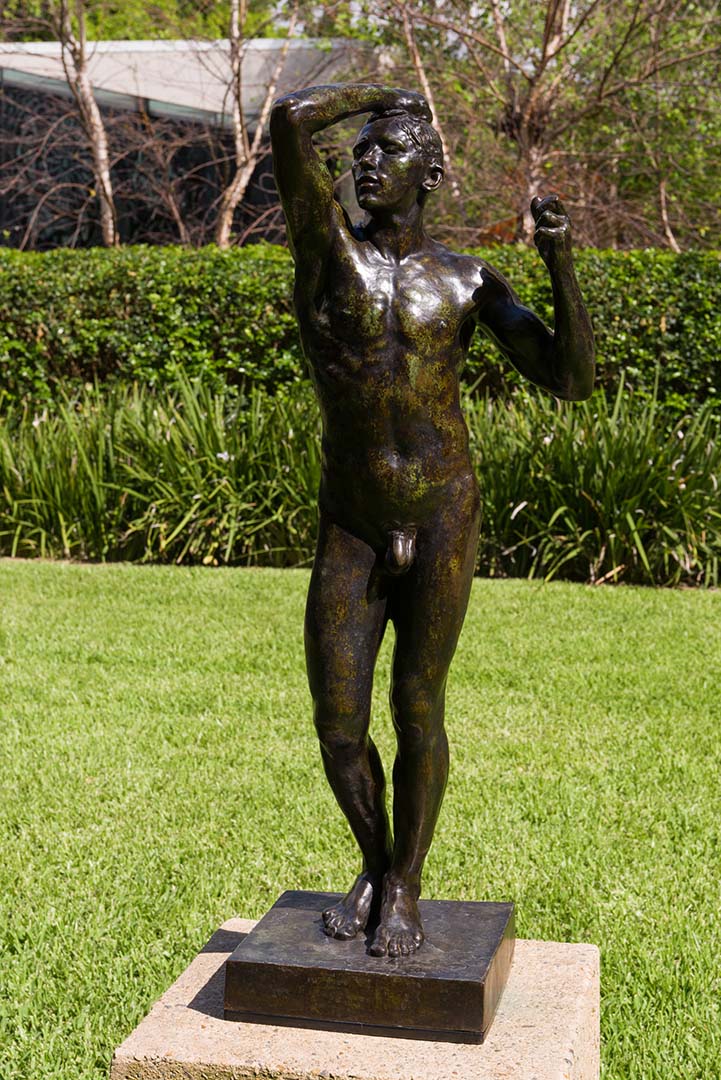We acknowledge the Traditional Owners of the land on which the Queensland Art Gallery | Gallery of Modern Art stands and recognise the creative contribution First Australians make to the art and culture of this country.

Auguste Rodin / France 1840–1917 / L’Age d’airain (The Bronze age) 1876-77, cast 1955 / Bronze, ed. of 12 / 99 x 12 x 29.5cm; 104 x 39.4 x 30.5cm (with base) / Purchased 1955. Beatrice Ethel Mallalieu Bequest / Collection: Queensland Art Gallery | Gallery of Modern Art
Auguste RodinL’Age d’airain (The Bronze age) 1876–1877
On Display: QAG, Sculpture Courtyard
Auguste Rodin’s L’Age du Bronze (Age of Bronze) was completed soon after his return to Paris from Italy in 1876, where he had been studying the sculpture of Michelangelo. During this period the Salons were showing renewed interest in the Italian Renaissance; however, the Paris public of the 1870s was unaccustomed to the presentation of a ‘living’ naked body in art.
L’Age du Bronze reflects the union of both traditional and modern tastes that has become evident in Rodin’s oeuvre. On the one hand, the sculpture represents an elegant subject, restricted in movement and having a stable posture. On the other hand, the sculpture also invites a reaction against tradition by its lack of literary or historical context. There is a notable absence of symbolic elements within the work itself to suggest the figure’s identity. Usually identity would reside in the sculpture’s title, however, L’Age du Bronze is but one of several titles Rodin assigned to the work.
It has shares similarities with Michelangelo’s Captive (The Rebellious Slave) 1513 (Collection: Musée Louvre) not only in composition, but also in the highly emotive restraint which radiates from the lone figure. Rodin’s reputation as the ‘master of the psychological portrait’2 is evident in this figure through the pose, expressing forces at play within — whether of suicide, the primeval man’s awakening to life or of the anguish Michelangelo’s sculpture similarly suggests.
Endnotes:
1. Tancock, J.L. The Sculpture of Auguste Rodin, David R. Godine, Boston, 1976, p.342.
The charismatic and obsessive French sculptor René Françoise Auguste Rodin (1840–1917) remains a fascinating figure, his work, the subject of numerous controversies during his lifetime, continues to inspire debate, particularly his intimate representations of the female figure. There is little dispute, however, about his importance to modern sculpture and his continuing influence on contemporary artists, writers, and even choreographers.
Born in 1840, the son of a police official, Rodin had no formal art training at an academy, but instead worked as an assistant in artists’ studios. This experience gave him a broad familiarity with mediums and techniques, and allowed him to experiment with a variety of materials — creating rich patinas by mixing copper and zinc; and using clay, wax, plaster, bronze and marble. Rodin said of this time: ‘Where did I learn to understand sculpture? In the woods by looking at the trees, along roads by observing the formation of clouds, in the studio by studying the model, everywhere except in the schools.’1
Fascinated by how the human body moves, Rodin would ask female models to walk nude around the studio, rather than holding a pose. He produced thousands of sketches and drawings, and preferred street performers, entertainers, dancers and acrobats as live models because their poses and gestures were less formal, more dynamic and more complex than traditional academic models. A distinguishing characteristic of Rodin’s sculptures is the internal, potential energy expressed through the shaping of muscle under smooth skin. Heavy texture is used as a device for moving the eye around the composition of the sculpture.
Endnotes:
1. Auguste Rodin, cited in Rachel Corbett, You Must Change Your Life: The Story of Rainer Maria Rilke and Auguste Rodin, W.W. Norton & Company, New York, 2016, p.12.